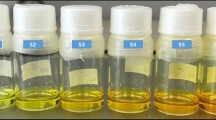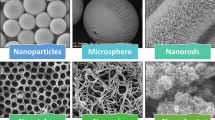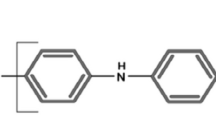Abstract
ZrO2:H thin films were deposited by DC magnetron sputtering at room temperature. The effects of thickness on structure and morphologies of ZrO2:H thin films were lucubrated. The X-ray photoelectron spectroscopy analysis reveals that the fully oxidized value of Zr (Zr4+) exists in both ZrO2 and ZrO2:H films. X-ray diffraction data show the crystallinity of ZrO2:H thin films tends to be weak and the microstructure changes slightly. Atomic force microscopy analysis presents that both the grain size and surface roughness increase as the thickness increases. Correspondingly, all-thin-film ITO/NiO x /ZrO2:H/WO3/ITO electrochromic devices (ECDs) were monolithically fabricated, among which the thickness of ZrO2:H film was adjusted. The ECD assembled with 50 nm ZrO2:H film has the best electrochromic property with transmittance modulation (ΔT) of 65.2 % at 550 nm. The effects of operation potential on ECDs were also elaborated studied. ECDs can get colored in saturated states at relatively high potential as no more unoccupied sites exist in WO3 to accommodate the continuously injected H+ ions.










Similar content being viewed by others
References
Chananonnawathorn C, Pudwat S, Horprathum M, Eiamchai P, Limnontakul P, Salawan C, Aiempanakit K (2012) Electrochromic property dependent on oxygen gas flow rate and films thickness of sputtered WO3 films. Procedia Eng 32:752–758
Wei YX, Zhou JL, Zheng JM, Xu CY (2015) Improved stability of electrochromic devices using Ti-doped V2O5 film. Electrochim Acta 166:277–284
Sezgin M, Ozay O, Koyuncu S, Ozay H, Koyuncu FB (2015) A neutral state colorless phosphazene/carbazole hybride dendron and its electrochromic device application. Chem Eng J 274:282–289
Sbar NL, Podbelski L, Yang HM, Pease B (2012) Electrochromic dynamic windows for office buildings. Int J Sustain Built Environ 1:125–139
Granqvist CG (2006) Electrochromic materials: out of a niche. Nat Mater 5:89–90
Madhavi V, Kondaiah P, Hussain OM, Uthanna S (2014) Structural, optical and electrochromic properties of RF magnetron sputtered WO3 thin films. Phys B 454:141–147
Manceriu LM, Rougier A, Duta A (2015) Comparative investigation of the Ti and Mo additives influence on the opto-electronic properties of the spray deposited WO3 thin films. J Alloys Compd 630:133–145
Chen TF, Wang AJ, Shang BY, Wu ZL, Li YL, Wang YS (2015) Property modulation of NiO films grown by radio frequency magnetron sputtering. J Alloys Compd 643:167–173
Kim SH, Ko JH, Ji SH, Kim JS, Kang SS, Lee MJ, Yoon YS (2006) Structural and electrochemical properties of ZrO2 · H x thin films deposited by reactive sputtering in hydrogen atmosphere as solid electrolyte. Jpn J Appl Phys 45:5144–5148
Jonsson AK (2002) Charge transport in transition metal oxide thin films and electrochromic devices. Ph.D. Thesis, (Dep. Of Material Science, Uppsala University)
Zhang HH, Ma CY, Zhang QY (2009) Scaling behavior and structure transition of ZrO2 films deposited by RF magnetron sputtering. Vacuum 83:1311–1316
Li N, Suzuki M, Abe Y, Kawamura M, Sasaki K, Itoh H, Suzuki T (2012) Effects of substrate temperature on the ion conductivity of hydrated ZrO2 thin films prepared by reactive sputtering in H2O atmosphere. Sol Energy Mater Sol Cells 99:160–165
Larsson AL, Niklasson GA (2004) Optical properties of electrochromic all-solid-state devices. Sol Energy Mater Sol Cells 84:351–360
Dalavi DS, Suryavanshi MJ, Patil DS, Mali SS, Moholkar AV, Kalagi SS, Vanalkar SA, Kang SR, Kim JH, Patil PS (2011) Nanoporous nickel oxide thin films and its improved electrochromic performance: effect of thickness. Appl Surf Sci 257:2647–2656
Patel KJ, Desai MS, Panchal CJ, Deota HN, Trivedi UB (2013) All-solid-thin film electrochromic devices consisting of layers ITO/NiO/ZrO2/WO3/ITO. J Nano-Electron Phys 5:02023
Tajima K, Yamada Y, Bao S, Okada M, Yoshimura K (2009) Electrochemical evaluation of Ta2O5 thin film for all-solid-state switchable mirror glass. Solid State Ionics 180:654–658
Cubillos GI, Bethencourt M, Olaya JJ (2015) Corrosion resistance of zirconium oxynitride coatings deposited via DC unbalanced magnetron sputtering and spray pyrolysis-nitriding. Appl Surf Sci 327:288–295
Wu X, Zhou P, Li J, Chen LY, Lv HB, Tang TA (2007) Reproducible unipolar resistance switching in stoichiometric ZrO2 films. Appl Phys Lett 90:183507
Maria H, Haley R (2009) Large cation model of dissociative reduction of electrochromic WO3-x films. Cent Eur J Chem 7:234–245
Avendaño E, Azens A, Isidorsson J, Karmhag R, Niklasson GA, Granqvist CG (2004) Optimized nickel-oxide-based electrochromic thin films. Solid State Ionics 165:169–173
Danine A, Cojocaru L, Faure C, Olivier C, Toupance T, Campet G, Rougier A (2014) Room temperature UV treated WO3 thin films for electrochromic devices on paper substrate. Electrochim Acta 129:113–119
Karuppasamy KM, Subrahmanyam A (2009) Studies on the correlation between electrochromic colouration and the relative density of tungsten trioxide (WO3-x ) thin films prepared by electron beam evaporation. J Phys D: Appl Phys 42:095301
Tai CY, Wu JY (2008) Observation of optical density modulation based on electrochromic tantalum oxide films. J Phys D: Appl Phys 41:065303
Granqvist CG (1995) Handbook of inorganic electrochromic materials. Elsevier, Amsterdam
Maria H, Lumbini ID, Haley R (2014) Lattic polarization effects in electrochromic switching in WO3-x films studied by pulse-nanogravimetric technique. J Solid State Electrochem 18:1251–1260
Mihelčič M, Vuk AŠ, Jerman I, Orel B, Švegl F, Moulki H, Faure C, Campet G, Rougier A (2014) Comparison of electrochromic properties of Ni1-x O in lithium and lithium-free aprotic electrolytes: from Ni1-x O pigment coatings to flexible electrochromic devices. Sol Energy Mater Sol Cells 120:116–130
Wang JY, Yu CM, Hwang SC, Ho KC, Chen LC (2008) Influence of coloring voltage on the optical performance and cycling stability of a polyaniline-indium hexacyanoferrate electrochromic system. Sol Energy Mater Sol Cells 92:112–119
Malini DR, Sanjeeviraja C (2013) H+-intercalation electrochemical/electrochromic properties of V-Ce mixed oxide thin films. Int J Electrochem Sci 8:1349–1365
Wang CK, Sahu DR, Wang SC, Lin CK, Huang JL (2012) Structural evolution and chemical bonds in electrochromic WO3 films during electrochemical cycles. J Phys D: Appl Phys 45:225303
Al-Kahlout A, Pawlicka A, Aegerter M (2006) Brown coloring electrochromic devices based on NiO-TiO2 layers. Sol Energy Mater Sol Cells 90:3583–3601
Acknowledgments
This work was supported by the National Natural Science Foundation of China (No. 51172013), Beijing Higher Education Young Elite Teacher Project (No. YETP1139), and the Fundamental Research Funds for the Central Universities.
Author information
Authors and Affiliations
Corresponding author
Rights and permissions
About this article
Cite this article
Zhou, Y., Diao, X., Dong, G. et al. Enhanced transmittance modulation of ITO/NiO x /ZrO2:H/WO3/ITO electrochromic devices. Ionics 22, 25–32 (2016). https://doi.org/10.1007/s11581-015-1591-z
Received:
Revised:
Accepted:
Published:
Issue Date:
DOI: https://doi.org/10.1007/s11581-015-1591-z




